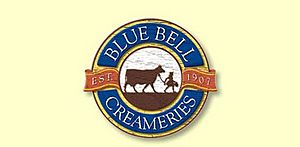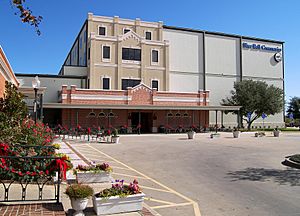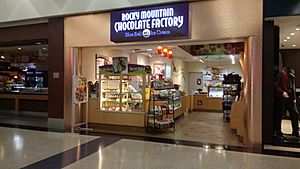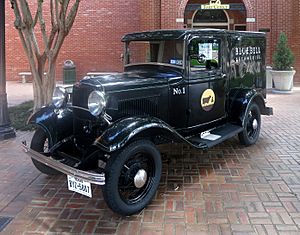Blue Bell Creameries facts for kids
 |
|
| Private | |
| Industry | Ice cream |
| Founded | 1907 Brenham, Texas, U.S. |
| Headquarters | Brenham, Texas, U.S. |
|
Key people
|
Jimmy Lawhorn, President |
| Revenue | Over US$500 million (2018) Estimated US$680 million (2014) |
|
Number of employees
|
Over 1,000 (2018) |
Blue Bell Creameries is a famous American company that makes delicious ice cream. It started way back in 1907 in a small town called Brenham, Texas. For many years, the company made both ice cream and butter. Later, it decided to focus only on ice cream.
Blue Bell ice cream became very popular. It spread from Texas to many other parts of the Southern United States. The company's main office is still in Brenham, Texas. The Kruse family has owned Blue Bell since 1919. In 2015, Blue Bell was one of the top-selling ice cream makers in the United States.
Contents
Blue Bell Ice Cream: A Sweet Story
How Blue Bell Started
The company began as the Brenham Creamery Company in 1907. Its first job was to buy extra cream from local dairy farmers. Then, it sold butter to people in Brenham, Texas. This town is about 70 miles northwest of Houston. In 1911, the creamery started making a little bit of ice cream.
By 1919, the company was having money problems. It almost had to close down. But then, a 23-year-old former teacher named E.F. Kruse was hired. He took over the company on April 1, 1919. Mr. Kruse didn't take a salary at first. He wanted to make sure the company didn't get into more debt.
Under his leadership, the company started making more ice cream. It sold ice cream to nearby areas around Brenham. Soon, the company was making money again! In 1930, Mr. Kruse suggested a new name. The company became Blue Bell Creameries. It was named after his favorite wildflower, the Texas bluebell. Like ice cream, these flowers grow well in the summer.
Growing Bigger and Better
For many years, Blue Bell made ice cream in small batches. In 1936, the company bought a new machine. This machine could make 80 gallons of ice cream every hour! The ice cream would flow out of a spout. This made it easy to fill containers of any size.
E.F. Kruse passed away in 1951. His sons, Ed and Howard, took over the company. By the 1960s, Blue Bell stopped making butter completely. They decided to focus only on ice cream. For a long time, Blue Bell only sold ice cream in Brenham. Then, they started selling it in Houston. Soon, they expanded across most of Texas. This included Dallas–Fort Worth metroplex and Austin.
By the end of the 1970s, sales had grown four times bigger. By 1980, the company was making over 10 million gallons of ice cream each year. This brought in $30 million annually.
In 1989, Blue Bell started selling ice cream in Oklahoma. Throughout the 1990s, they expanded more. They reached the South Central and Southern United States. This included cities like New Orleans and Jackson, Mississippi. In 1992, Blue Bell built a new factory in Broken Arrow, Oklahoma. Four years later, in 1996, they opened a third factory in Sylacauga, Alabama. This helped them expand into Atlanta and Miami.
Blue Bell takes its time to expand to new places. They research each new market carefully. They also make sure all new employees are well-trained. This helps them keep their ice cream quality high. Blue Bell often expands to new markets in March. For example, they came to Colorado in March 2011. They also expanded to Virginia in 2013 and Las Vegas in 2014. When they expand, they build new distribution centers. These centers help deliver ice cream to stores within a 75-mile area.
In February 2025, Blue Bell ice cream was introduced to southern Utah for the first time.
Making Ice Cream Today

As of 2015, Blue Bell had three factories. The biggest one is in Brenham, Texas. The other two are in Broken Arrow, Oklahoma, and Sylacauga, Alabama. Before a big recall in 2015, Blue Bell had 50 sales and distribution centers. These centers were spread across 24 states. The company had about 2,800 employees. About 850 of them worked in Brenham. In 2006, the company's yearly sales were over $400 million.
Blue Bell controls every step of its business. This helps them make sure their ice cream is always top quality. They use the freshest ingredients. The milk they use is very fresh, often from cows that were just eating grass yesterday. The cream used each day is less than 24 hours old. All the ice cream is made and packaged in Blue Bell factories. These factories can make over 100 pints of ice cream every minute. Even the delivery drivers help stock the store shelves. This ensures the ice cream is handled correctly.
In 2014, Blue Bell was the best-selling ice cream brand in the United States. This is according to Statista, a market data company. Blue Bell mostly sells its ice cream in the Southern United States. It has also been sold as far west as Las Vegas, as far north as Indianapolis and Denver, and as far east as Richmond, Virginia. This area is only about 20% of the United States. Other big ice cream companies sell their products across the whole country. But Blue Bell is often the top seller in the areas where it does sell. For example, in Texas, Blue Bell has 52% of the ice cream market. In Baton Rouge, Louisiana, they had 35% of the market within five months.
People outside the sales area can sometimes have the ice cream shipped to them. Former President George W. Bush often had Blue Bell ice cream sent to Camp David. In 2006 and 2012, astronauts on the International Space Station also enjoyed Blue Bell ice cream. It was sent to help make the crew happy.
Popular Flavors and Products

Blue Bell makes over 250 different frozen treats. About 66 of these are ice cream flavors. Twenty flavors are available all year. Another two to three dozen flavors are offered only during certain seasons. Besides ice cream, Blue Bell also makes frozen yogurt, sherbet, and frozen treats on a stick.
Unlike some other companies, Blue Bell still sells true half-gallon (64 fl oz) containers. Many competitors have made their standard containers smaller. Blue Bell often mentions this in its advertisements.
The company introduced its most popular flavor, Homemade Vanilla, in 1969. Blue Bell was also the first company to make cookies 'n cream ice cream in large amounts. At first, they used Oreo cookies. But now, they bake their own cookies for this flavor. In 1997, Blue Bell Homemade Vanilla was the best-selling single flavor of ice cream in the United States. In 2001, Forbes magazine called Blue Bell the best ice cream in the country.
A writer for The New York Times, R.W. Apple Jr., wrote about Blue Bell in 2006. He said it had "clean, vibrant flavors" and a "rich, luxuriant consistency." He felt it was much better than many other mass-produced ice creams.
Sometimes, when Blue Bell enters a new market, they introduce a special flavor just for that area. For example, when they came to Colorado in March 2011, they introduced Rocky Mountain Road. This flavor had special ingredients like chocolate-covered nuts and marshmallow swirl. Later, this flavor was sold across all of Blue Bell's sales areas.
In May 2025, Blue Bell announced they are bringing back Groom's Cake Ice Cream for a limited time. This flavor was stopped in 2018. But it was fans' top choice in a special flavor tournament in 2024.
In 2018, some children asked Blue Bell to change the name of their "The Great Divide" flavor. This flavor has equal parts of chocolate and vanilla ice cream. The children suggested "Better Together" instead. Blue Bell liked the idea, but some people on social media disagreed.
In July 2019, a video went viral of a teenager licking a Blue Bell ice cream tub in a store. Then, she put it back in the freezer. She was later arrested. Other similar bad pranks happened, and some people were jailed. These incidents showed how important it is to keep food safe. People also said Blue Bell should add a plastic seal to their ice cream tubs.
A Big Challenge: The 2015 Recall
In 2015, Blue Bell had to recall its products for the first time in its 108-year history. This happened because of a health concern. Five people in Kansas became sick with listeriosis. This was thought to be caused by products from the Broken Arrow, Oklahoma, factory. Sadly, three of these people passed away.
Blue Bell recalled some products and temporarily closed its Broken Arrow factory. But tests found the bacteria, called Listeria, in other places and plants too. Because of this, on April 20, 2015, Blue Bell recalled all of its products. This meant over eight million gallons of ice cream had to be thrown away.
The company stopped making ice cream and started cleaning and repairing its factories. The FDA found that Blue Bell had not followed all the rules to prevent contamination. They had found Listeria in the Broken Arrow factory two years before the recalls. At the main factory in Brenham, one machine was so contaminated that Blue Bell decided to stop using it forever. There was also condensation (water drops) in parts of the Brenham factory.
Blue Bell had to make some tough decisions. On May 15, they announced job cuts and temporary layoffs. About 1,450 employees were laid off. Another 1,400 employees were temporarily out of work until the factories were clean. The remaining employees had their wages reduced.
Blue Bell also had to close 15 of its distribution centers for a while. This was because they couldn't make enough ice cream to supply all their markets. The recalls were so serious that they threatened the company's future.
Getting Back on Track
On July 14, 2015, a Texas investor named Sid Bass helped Blue Bell. He invested money in the company. Blue Bell received a $125 million loan to keep going. Around the same time, the factory in Sylacauga, Alabama, started making ice cream again. They made test batches. The ice cream was not sold until it tested negative for all bacteria, including Listeria.
On August 17, 2015, Blue Bell announced a five-step plan to bring its ice cream back to stores.
- Phase 1: Houston and Austin areas of Texas, plus Birmingham and Montgomery areas of Alabama.
- Phase 2: North central Texas (Dallas–Fort Worth) and northern Oklahoma including Tulsa.
- Phase 3: Southwest Texas (San Antonio) and central Oklahoma including Oklahoma City.
- Phase 4: Most of Texas plus southern Louisiana including Baton Rouge and New Orleans.
- Phase 5: The rest of Texas, Alabama, Oklahoma, and Louisiana. Also, all of Arkansas, Florida, and Mississippi. And parts of Georgia, Kentucky, Missouri, New Mexico, North Carolina, South Carolina, Tennessee, and Virginia.
Phase 1 began on August 31, 2015. Phase 2 started in November 2015. Phases 3 and 4 began a month later. On September 1, Blue Bell also started making ice cream again at its Broken Arrow, Oklahoma, factory.
On January 28, 2016, the company started distributing to large parts of the Southeastern US again. On March 6, 2017, Blue Bell reopened its distribution centers in Tucson and Phoenix. This completed distribution across Arizona. In March 2018, the company began distributing to much of Indiana, parts of Kentucky, and northern New Mexico. In March 2019, they returned to much of Virginia, northeastern North Carolina, and greater Kansas City. In March 2022, distribution returned to Clark & Nye counties in Nevada. In mid-April 2023, distribution returned to Wichita, Kansas.
What Happened Next
The United States Department of Justice (DOJ) looked into what happened at Blue Bell. They wanted to understand what company leaders knew about the contamination. In 2020, the company admitted to distributing contaminated products. They paid a fine of $19.35 million.
Paul Kruse, who was Blue Bell's CEO during the outbreak, was also investigated. In 2020, he was charged with several crimes. In August 2022, his trial ended without a clear decision from the jury. A new trial was planned for April 2023. But in March, Mr. Kruse made a deal with the DOJ. He pleaded guilty to a minor charge related to distributing unsafe ice cream. He paid a $100,000 fine. He was not sent to prison.
|
See also
 In Spanish: Blue Bell Creameries para niños
In Spanish: Blue Bell Creameries para niños


